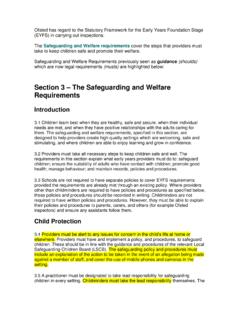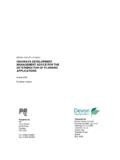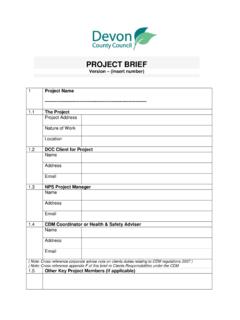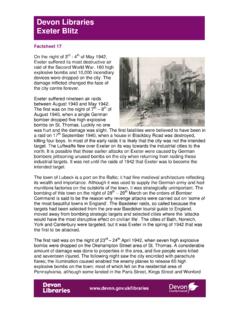Transcription of Food labelling for Cake Makers 191212 - Devon …
1 food labelling for Cake Makers This leaflet covers the labelling of cakes which are: displayed for sale in a loose or unwrapped state pre-packed for sale on those same premises pre-packed for sale, by the packer, from their market stalls or mobile vehicles or any other premises of theirs trading under the same name If you plan to sell cakes via a third party retailer, full labelling rules apply and you can visit our website or contact an officer for more advice. General labelling requirements: Irradiation - food or ingredients that have been irradiated must be declared and labelled 'irradiated' or 'treated with ionising radiation'.
2 Genetic modification - If any of the food contains genetically modified ingredients, it must either be labelled 'produced from genetically modified ingredients', or this statement must appear on a notice, label, or ticket near the food . Cake and confectionery labelling : Names of cakes : Generally, cakes are not required to be labelled with their name. However, if you choose to do so you must ensure that the description is true and accurate. For example: it is important to realise that, in food Law, the words 'flavoured' and 'flavour' have very different meanings - for example, vanilla flavoured icing derives its flavour only from real vanilla, but vanilla flavour icing is synthetically flavoured - if neither word is used (vanilla slice for example)
3 The flavour must be only from natural vanilla the cream in cream cakes must be wholly dairy cream - if any artificial or imitation cream is used, the name of the cake must be qualified accordingly imitation cream and imitation chocolate must not be described as cream or creme, chocolate or choc Additives in cakes : If cakes contain Antioxidants, Flavour Enhancers, Sweeteners, Colours, Flavourings or Preservatives: there must be a specific notice on them clearly and conspicuously telling the customers which of those types of additives are present in those particular cakes or; the shop must display a general notice (see example below) in a prominent position near the food , telling customers that cakes sold there may contain such additives Example of General Notice labelling of colours for all types of bakery products: E102 Tartrazine E122 Carmoisine E104 Quinoline Yellow E124 Ponceau 4R Blue E110 Sunset Yellow E129 Allura Red These six colours have been subject to a request for voluntary withdrawal in the UK by the food Standards Agency.
4 Under EU law from 20 July 2010 products containing these colours must be labelled with the following information: '(E number/ name of colour) may have an adverse effect on activity and attention in children'. food labelling Regulations 1996 Customers are advised that some of the cakes and flour confectionery sold on these premises may contain one, or more, of the following types of additives: Antioxidants Flavour Enhancers Sweeteners Colours Flavourings Preservatives Allergens It is good practice to label any allergenic ingredients. These are: cereals containing gluten: wheat, rye, barley, oats, spelt, kamut and their hybridised strains crustaceans eggs fish peanuts soybeans milk nuts including almonds, hazelnuts, walnuts, cashews, pecans, Brazil nuts, pistachios, macadamias, and Queensland nuts celery mustard sesame seeds sulphur dioxide and sulphites at concentrations of more than 10mg/kg or 10mg/litre expressed as SO2.
5 ( dried or preserved fruit may contain this) lupins molluscs Gluten Free Claims Please note terms such as, Gluten free/ wheat free/ suitable for coeliacs are covered by specific legislation and can only be used on foods that contain less than 20 parts of gluten in a million. The food Standards Agency has guidance on this. Nutritional labelling There is no legal requirement to give nutritional information BUT if you make claims about the product you will have to do so. If you give nutritional information, either to comply with the regulations, or voluntarily, they must be in one of the two formats below: Per 100g or per 100ml: Per 100g or per 100ml: Energy - kcal/kJ Protein - g Carbohydrate - g Fat - g Energy - kcal/kJ Protein - g Carbohydrate - g of which sugars - g Fat - g of which saturates - g Fibre - g Salt - g You may give additional nutritional information in this format per specified serving, per biscuit, or per serving.
6 cakes sold in Catering premises These need a name of the food It is good practice to supply the caterer with full information such as the ingredients list, any allergenic ingredients and durability date. Bespoke cakes If you produce one off or occasion cakes to order for individual customers you have a duty to accurately describe the product. It would be good practice to give as much information as possible including the legally required additives, allergen declaration and the durability date. Edible glitters and dusts Only glitter or dust clearly labelled as edible should be applied to food for consumption.
7 Some non-edible cake decorating materials, described as dusts or glitters, are being marketed in ways that could be misleading. These include products only labelled as non-toxic , without stating they are not to be consumed. Dusts or glitters that are edible will be made of permitted additives (such as mica and titanium dioxide) and must comply with the requirements of EU food additives legislation. Edible glitter or dust must be labelled with the name or E-number of any additives used and should carry either the statement For food ', Restricted use in food ' or a more specific reference to their intended food use (for example Edible lustre ).
8 Consumers who are unsure if a non-toxic glitter or dust is safe for use in contact with food should contact the glitter or dust supplier. Glitter manufacturers have to provide suppliers with a declaration of compliance to show the product(s) meet the requirements of legislation for food contact materials and articles. The following is a link to the food Standards Agency guidance for the use of glitters and dusts with food . Please note: This leaflet is not an authoritative interpretation of the law and is intended only for guidance. For further information, or if you intend to sell your products through other retail shops please contact us either by our website or during business hours on 01392 381381.
9 Last reviewed/updated: December 2012 Version









